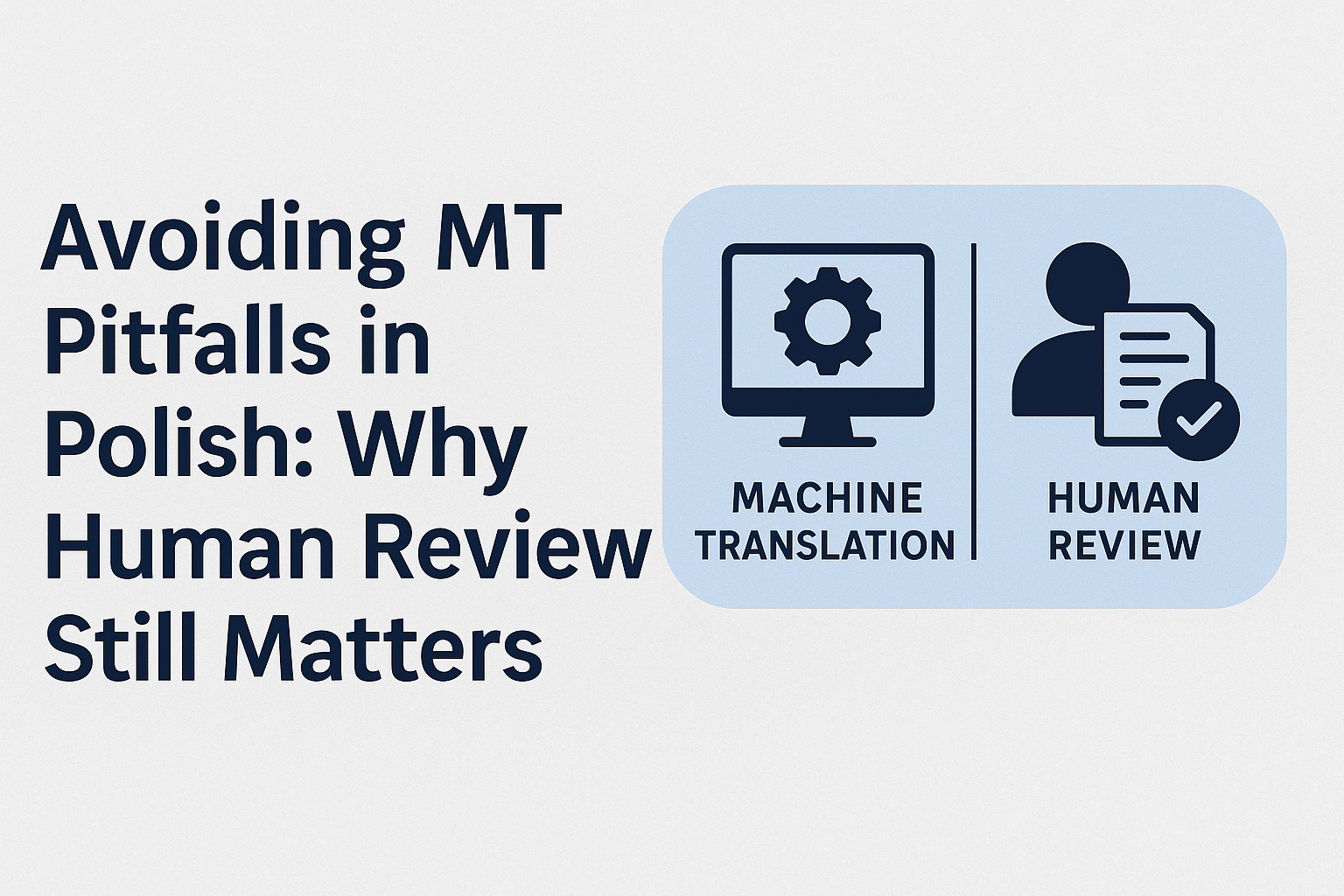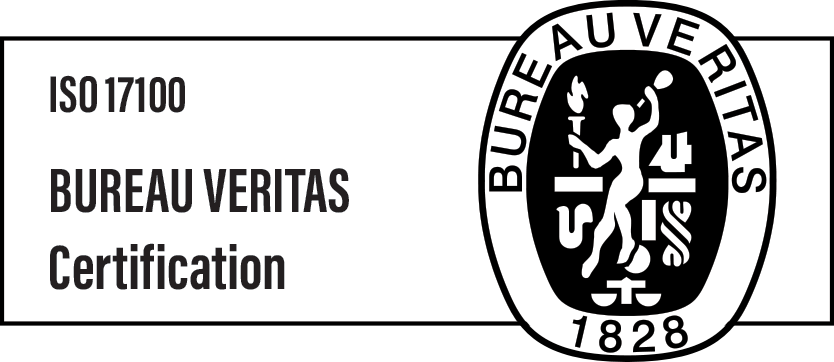Avoiding MT pitfalls in Polish: Why human review still matters

The promise- and limits- of machine translation
Machine translation has quickly become a go-to solution for companies looking to scale their content across multiple languages. It’s fast, relatively inexpensive, and keeps getting better. For many high-volume or time-sensitive projects, using MT can feel like a smart business move.
However, when it comes to Polish, things aren’t always so straightforward.
Polish is a linguistically rich and highly inflected language. That means word endings, grammar, and syntax change based on context—and machines often struggle to keep up. While MT tools may produce output that looks clean on the surface, deeper issues can go unnoticed without a human reviewer. These are the kinds of errors that confuse users, damage credibility, and create extra work later on.
Relying too heavily on MT without proper human oversight can lead to costly mistakes, especially in industries where clarity and tone matter. If you’re an LSP or a localization manager working with Polish, you need more than just automation. You need language professionals who understand the complexities of Polish and know how to catch what machines miss.
In this article, we’ll look at why Polish presents unique challenges for MT, the common pitfalls that crop up, and how human reviewers help keep your content sharp, accurate, and trustworthy.

The complexity of Polish grammar and context
The complexity of Polish grammar and context
Polish is not a machine-friendly language. Its grammatical structure is far more intricate than English or other Germanic languages, which are often used as MT training bases. One of the biggest hurdles is inflection. In Polish, nouns, adjectives, and verbs change form depending on gender, number, and case. That adds layers of meaning that machines can easily misread or ignore.
Word order is another challenge. Polish is syntactically flexible, which means the same sentence can be phrased in several ways without changing its meaning. This flexibility often causes MT engines to produce translations that are technically correct but sound unnatural or jumbled to a native speaker. Machines tend to default to English word order, which doesn’t always work in Polish.
Context also plays a huge role. In Polish, a single word can have several meanings depending on the sentence. Machines often select the most statistically likely option, but that’s not always the correct one. Without a full understanding of the surrounding text, MT systems are prone to choosing the wrong form or nuance.
The result is a translation that may seem fine at a glance but falls apart under close reading. This is especially dangerous in professional settings, where tone, precision, and cultural cues matter. Without human input, even the most advanced MT system can turn polished source content into something confusing or misleading.

Common machine translation pitfalls specific to Polish
Common machine translation pitfalls specific to Polish
Many of the most frequent MT errors in Polish are subtle—but they matter. One common issue is incorrect case usage. For example, Polish requires different noun forms depending on sentence function, and MT engines often miss these distinctions. The wrong case can make a sentence grammatically incorrect or awkward, even if the vocabulary is accurate.
Aspect confusion is another pitfall. Polish verbs come in perfective and imperfective forms, each suited to different types of actions. Machines struggle to choose the right one, especially without time indicators. The result is verbs that sound wrong or misrepresent the intended meaning.
Then there’s the problem of false friends and literal translations. Words that look similar in English and Polish don’t always carry the same meaning. MT often translates them word-for-word, which can lead to misleading or even embarrassing errors. Idiomatic expressions fare no better—machines typically translate them literally, creating phrases that don’t make sense to a native speaker.
Syntax is also a weak spot. English sentence structures don’t always map well onto Polish ones. MT often tries to mirror the original format too closely, leading to awkward or unnatural phrasing. This is particularly noticeable in marketing copy or UI strings, where fluency and readability are essential.
For LSPs and localization teams, understanding these common pitfalls is the first step. But preventing them requires something MT alone can’t provide: human insight.

The risks of skipping human review
The risks of skipping human review
Skipping human review might seem like a time-saver, but for Polish, it’s a gamble. Machine translation engines often produce sentences that look fluent but contain subtle errors. These issues aren’t always visible to non-native speakers or automatic QA tools. Unfortunately, small mistakes can have big consequences—especially in content that influences trust, compliance, or brand perception.
For example, if a legal document uses the wrong case ending or verb aspect, the meaning can shift enough to create ambiguity or legal exposure. If customer-facing text sounds robotic or awkward, it can undermine the user experience and reduce engagement. Polish users are highly attuned to unnatural phrasing, and a poor translation can quickly make a brand seem careless or unprofessional.
There’s also the issue of compounding errors. When MT output is used without human checks, errors can carry over into subsequent translations, glossaries, and even future AI training data. This leads to a long-term drop in consistency and quality.
Perhaps the most dangerous assumption is that MT is “good enough.” If no one is reviewing the output closely, mistakes may never be caught until they cause real damage. And at that point, fixing them becomes more expensive than doing it right the first time.
For LSPs serving demanding clients—or clients working in high-risk industries—skipping human review is rarely worth the risk. It’s not just about checking grammar. It’s about protecting quality, accuracy, and trust.

What human reviewers bring to the table
What human reviewers bring to the table
Human reviewers do much more than fix grammar. They bring critical thinking, cultural understanding, and real-world knowledge that machines can’t replicate. A skilled Polish linguist doesn’t just look at whether the translation is correct—they consider how it sounds, who it’s for, and whether it fits the brand or purpose.
Reviewers also ensure consistency. They apply terminology from glossaries, maintain voice and tone across projects, and spot subtle deviations that MT engines often miss. In structured content like user manuals, that consistency boosts usability. In marketing copy, it reinforces brand identity.
Style matters too. Machines often produce clunky, literal language that just doesn’t feel natural. A human can reshape those phrases into fluent, persuasive Polish. That makes a huge difference in customer-facing materials, UX text, or anywhere the message needs to be smooth and engaging.
Cultural context is another area where humans excel. They recognize when a direct translation won’t work and can adapt the content to suit local norms or expectations. Whether that means softening a phrase, swapping an idiom, or rewriting for tone, human reviewers act as cultural gatekeepers.
In short, MT may get the job done, but human reviewers make sure it’s done right. For LSPs, this added layer of expertise turns raw output into reliable, publication-ready content.
Polish demands precision- humans deliver it
Machine translation has earned its place in modern workflows, but it’s not a silver bullet—especially for a language as complex as Polish. While MT can speed things up and reduce costs, it also introduces risk if used without proper oversight.
Polish grammar, syntax, and cultural context require a level of nuance that machines can’t consistently deliver. That’s where human reviewers make all the difference. They ensure your message isn’t just accurate, but clear, fluent, and aligned with your goals.
For LSPs and localization managers, investing in human review isn’t just about error prevention. It’s about delivering content that builds trust, serves users, and upholds your reputation. In Polish, that’s not a luxury—it’s a necessity.

